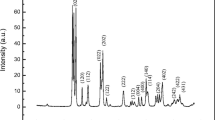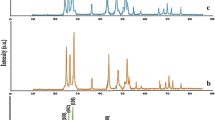Abstract
A novel sonocatalyst CdS was prepared by a facile precipitation method, and characterized by X-ray powder diffraction, transmission electron microscopy, UV-vis absorption spectroscopy, and photoluminescence spectroscopy. Comparative sonocatalytic degradation experiments were carried out in different conditions under ultrasonic irradiation and with rhodamine B (RhB) used as the model substrate. Results indicate that CdS is a highly active sonocatalyst. The efficiency of RhB sonodegradation in aqueous solutions within 4 h is up to 70% after the addition of CdS. Abundant •OH during the RhB sonodegradation was detected, which may be responsible for the high sonodegradation rate over CdS under ultrasonic radiation.










Similar content being viewed by others
References
Chang J, Chou C, Lin Y (2001) Kinetic characteristics of bacterial azo dye decolorization by Pseudomonas luteola. Water Res 35:841–2850
Gao YQ, Gao NY, Gu JS, Gu YL, Zhang D (2013) Factor affecting sonolytic degradation of sulfamethazine in water. Ultrason Sonochem 20(6):1401–1407. https://doi.org/10.1016/j.ultsonch.2013.04.007
Hirakawa T, Nosaka Y (2002) Properties of •O2 − and OH• formed in TiO2 aqueous suspensions by photocatalytic reaction and the influence of H2O2 and some ions. Langmuir 18(8):3247–3254. https://doi.org/10.1021/la015685a
Huang YY, Wang GW, Zhang HB, Li GS, Fang Da W, Wang J, Song YT (2017a) Hydrothermal-precipitation preparation of CdS@(Er3+:Y3Al5O12/ZrO2) coated composite and sonocatalytic degradation of caffeine. Ultrason Sonochem 37:222–234. https://doi.org/10.1016/j.ultsonch.2017.01.009
Huang YY, Zhang HB, Wei CS, Li GS, Wu Q, Wang J, Song YT (2017b) Assisted sonocatalytic degradation of pethidine hydrochloride (dolantin) with some inorganic oxidants caused by CdS-coated ZrO2 composite. Sep Purif Technol 172:202–210. https://doi.org/10.1016/j.seppur.2016.08.018
Kubo M, Fukuda H, Chua XJ, Yonemoto T (2007) Kinetics of ultrasonic degradation of phenol in the presence of composite particles of titanium dioxide and activated carbon. Ind Eng Chem Res 46(3):699–704. https://doi.org/10.1021/ie0607999
Li GS, Zhang HB, Wei CS, Huang YY, Dou XK, Wang YD, Wang J, Song YT (2017) Preparation of (5.0%)Er3+:Y3Al5O12/Pt-(TiO2-Ta2O5) nanocatalysts and application in sonocatalytic decomposition of ametryn in aqueous solution. Ultrason Sonochem 34:763–773
Lucas MS, Dias AA, Sampaio A, Amaral C, Peres JA (2007) Degradation of a textile reactive Azo dye by a combined chemical-biological process: Fenton’s reagent-yeast. Water Res 41(5):1103–1109. https://doi.org/10.1016/j.watres.2006.12.013
Midathana VR, Moholkar VS (2009) Mechanistic studies in ultrasound-assisted adsorption for removal of aromatic pollutants. Ind Eng Chem Res 48(15):7368–7377. https://doi.org/10.1021/ie900049e
Mukesh G, Hu HQ, Arun SM, Madhumita BR (2004) Sonochemical decomposition of volatile and non-volatile organic compounds—a comparative study. Water Res 38:4247–4261
Salem IA, EI-Maazawi MS (2000) Kinetics and mechanism of color removal of methylene blue with hydrogen peroxide catalyzed by some supported alumina surfaces. Chemosphere 41(8):1173–1180. https://doi.org/10.1016/S0045-6535(00)00009-6
Serkiz SM, Perdue EM (1990) Isolation of dissolved organic matter from the Suwannee River using reverse osmosis. Water Res 24(7):911–916. https://doi.org/10.1016/0043-1354(90)90142-S
Song LM, Zhang SJ, Wei QW (2012a) Porous BiOI sonocatalysts: hydrothermal synthesis, characterization, sonocatalytic, and kinetic properties. Ind Eng Chem Res 51(3):1193–1197. https://doi.org/10.1021/ie201753a
Song LM, Zhang SJ, Wu XQ, Wei QW (2012b) Synthesis of porous and trigonal TiO2 nanoflake, its high activity for sonocatalytic degradation of rhodamine B and kinetic analysis. Ultrason Sonochem 19(6):1169–1173. https://doi.org/10.1016/j.ultsonch.2012.03.011
Wang GW, Huang YY, Li G, Zhang HB, Wang YD, Li BW, Wang J, Song YT (2017) Preparation of a novel sonocatalyst, Au/NiGa2O4-Au-Bi2O3 nanocomposite, and application in sonocatalytic degradation of organic pollutants. Ultrason Sonochem 38:335–346. https://doi.org/10.1016/j.ultsonch.2017.03.031
Wang J, Ma T, Zhang ZH, Zhang XD, Jiang YF (2007a) Investigation on the sonocatalytic degradation of acid red B in the presence of nanometer TiO2 catalysts and comparison of catalytic activities of anatase and rutile TiO2 powders. Ultrason Sonochem 14(2):246–252. https://doi.org/10.1016/j.ultsonch.2006.05.003
Wang J, Ma T, Zhang ZH, Zhang XD, Jiang YF, Sun W, Li RH, Zhang P (2007b) Investigation on the transition crystal of ordinary rutile TiO2 powder by microwave irradiation in hydrogen peroxide solution and its sonocatalytic activity. Ultrason Sonochem 14(5):575–582. https://doi.org/10.1016/j.ultsonch.2006.11.006
Wang J, Sun W, Zhang ZH, Xing ZQ, Xu R, Li RH, Li Y, Zhang XD (2008) Treatment of nano-sized rutile phase TiO2 powder under ultrasonic irradiation in hydrogen peroxide solution and investigation of its sonocatalytic activity. Ultrason Sonochem 15(4):301–307. https://doi.org/10.1016/j.ultsonch.2007.07.001
Zhang GM, Wu MS, Zhang XH (2004) Study of 2-chlorobiphenyl and 4-chlorobiphenyl sonication. Environ Chem 23:298–300
Zhang HB, Huang YY, Li GS, Wang GW, Fang DW, Song YT, Wang J (2017) Preparation of Er3+:Y3Al5O12/WO3-KNbO3 composite and application in treatment of methamphetamine under ultrasonic irradiation. Ultrason Sonochem 35(Pt A):478–488. https://doi.org/10.1016/j.ultsonch.2016.11.004
Zhang HB, Qiao J, Li GS, Li SY, Wang GW, Wang J, Song YT (2018) Preparation of Ce4+-doped BaZrO3 by hydrothermal method and application in dual-frequent sonocatalytic degradation of norfloxacin in aqueous solution. Ultrason Sonochem 42:356–367. https://doi.org/10.1016/j.ultsonch.2017.11.043
Zhang HB, Wei CSB, Huang YY, Li GS, Wu Q, Wang J, Song YT (2016) Preparation of Er3+:Y3Al5O12/KNbO3composite and application in innocent treatment of ketamine by using sonocatalytic decomposition method. J Hazard Mater 317:667–676. https://doi.org/10.1016/j.jhazmat.2016.03.097
Author information
Authors and Affiliations
Corresponding author
Additional information
Responsible editor: Philippe Garrigues
Rights and permissions
About this article
Cite this article
Song, L., Li, Y. & Zhang, S. Sonocatalytic degradation of rhodamine B in presence of CdS. Environ Sci Pollut Res 25, 10714–10719 (2018). https://doi.org/10.1007/s11356-018-1369-8
Received:
Accepted:
Published:
Issue Date:
DOI: https://doi.org/10.1007/s11356-018-1369-8




